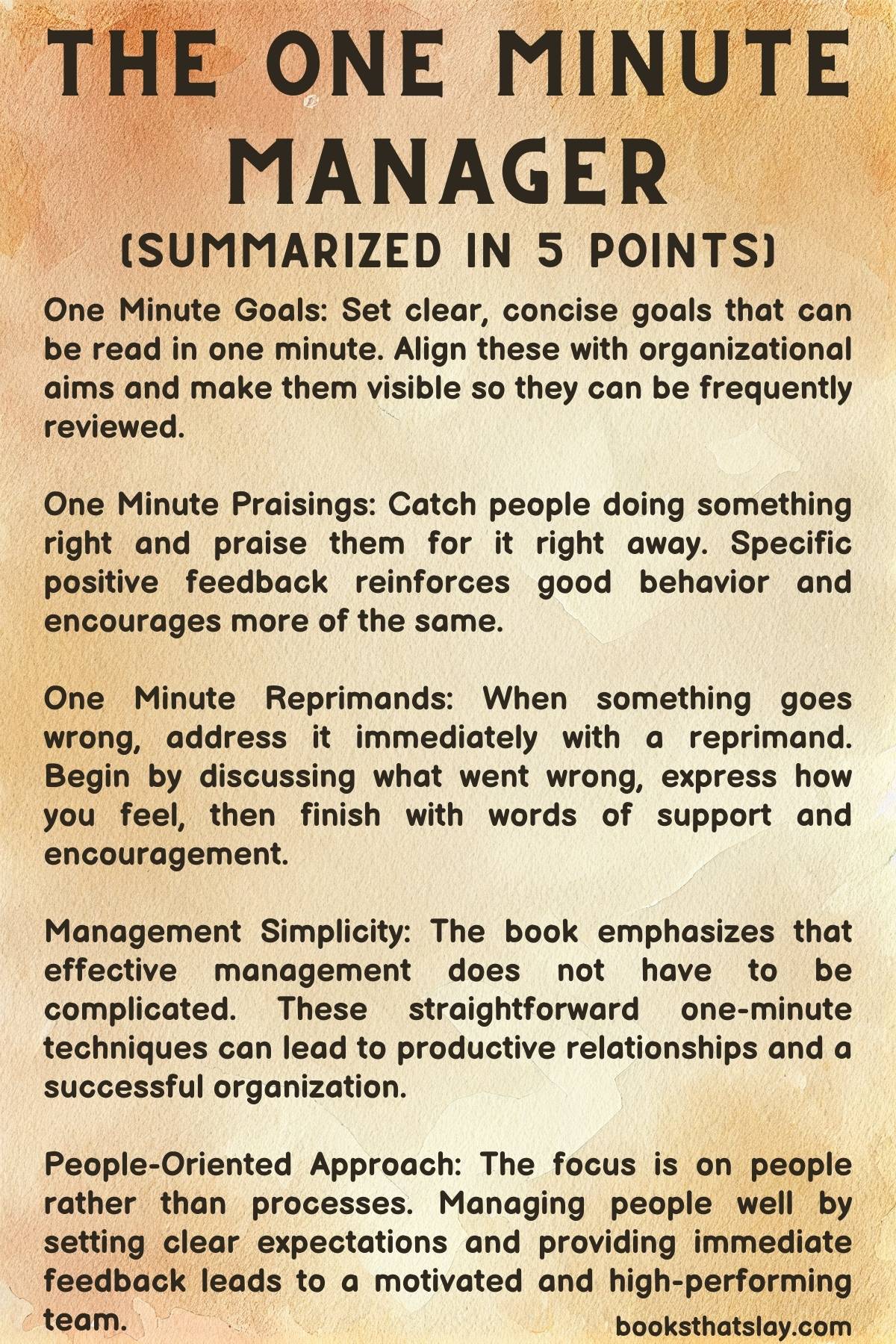The One Minute Manager | Summary and Key Lessons
“The One Minute Manager,” co-authored by Ken Blanchard and Spencer Johnson, is a parable-style business guide that provides concise, actionable advice for effective management. It teaches the principles of a quick, efficient, and effective managerial style, using a narrative about a young man searching for an effective manager to mentor him.
The book is built around the “one minute” concept, advocating the belief that an effective manager makes use of valuable minutes for maximized productivity and relationship building.
The One Minute Manager Summary
The book introduces three core ‘One Minute’ techniques: One Minute Goals, One Minute Praisings, and One Minute Reprimands.
One Minute Goals
The book’s first key idea is One Minute Goals, where managers set clear, concise goals for their employees at the very beginning.
These goals should ideally be understood and agreed upon, and be written on a single sheet of paper. Each goal is described in fewer than 250 words.
The employee keeps this paper and frequently reviews it to ensure they are working towards these goals.
The purpose of One Minute Goals is to ensure that responsibilities are clear and that employees know exactly what is expected of them.
It reinforces that the individual’s job aligns with the goals of the organization, and it encourages autonomy as it allows employees to manage themselves towards these objectives.
One Minute Praisings
One Minute Praisings is the second concept.
The manager catches the employee doing something right and immediately gives specific praise.
The feedback is direct, praising not just results but also the effort and the behavior leading to the result. It is personal and sincere, meant to increase an employee’s sense of self-worth and motivation.
This method of management fosters positive reinforcement and encourages employees to continue performing well.
It is based on the belief that “helping people reach their full potential often means more than just showing the way and giving instructions, it means bringing the best in them and allowing them to shine.“
One Minute Reprimands
The final concept is the One Minute Reprimands.
This is implemented when an employee does something wrong.
The reprimand is immediate, specific about the wrongdoing, and given in a clear and direct manner. However, it’s important to remember that the reprimand is directed at the behavior, not the person.
The reprimand begins with expressing how one feels about the mistake and its impact, but it ends on a positive, encouraging note, making it clear that the manager values the individual separate from their performance.

Also Read: The Black Swan | Summary and Key Lessons
What can you learn from the book?
1. Learn to set SMART goals
Based on the first concept, the book emphasizes that a manager must spend a minute at the start of a new task or project setting precise, understandable, and measurable goals.
This means that both the manager and the employee have a mutual understanding of what is expected, thereby reducing ambiguity.
The concept is rooted in the SMART goal-setting framework, which stands for Specific, Measurable, Achievable, Relevant, and Time-Bound.
For example, instead of setting a goal like “Increase sales,” a one minute manager might say, “Increase sales of product X by 15% over the next quarter.”
This goal is explicit, has a measurable outcome, is potentially achievable, pertains to the job, and is time-limited.
2. Praise your employees
According to the book, an effective manager takes a minute out of their day to catch their employees doing something right and offers sincere praise and acknowledgment.
This is important for building a positive work environment and boosting employee morale.
For instance, if an employee completes a task exceptionally well or ahead of the deadline, a one-minute manager would not hesitate to express their appreciation right away.
This immediate, positive feedback encourages employees to repeat the desirable behavior, driving performance and promoting a positive company culture.
Also Read: Thank You for Arguing | Summary and Key Lessons
3. Implementation of One-Minute Reprimands
The third lesson revolves around the concept of one minute reprimands. These are immediate and direct feedback sessions where the manager quickly addresses a mistake or poor performance.
The manager spends one half of the minute explaining what the employee did wrong, focusing on the behavior, not the person. The second half is spent reminding the employee of their value and the high expectations the manager has for them.
For example, if a project is delivered late without prior notice, a one minute manager would immediately address this by explaining the implications of the delay, expressing dissatisfaction towards the behavior, not the individual, and then reinforcing their belief in the employee’s abilities and potential.
4. Simplify your management techniques
Effective management techniques need not be complex or time-consuming.
The one-minute strategies discussed in the book are simple, direct, and focus on human interaction, demonstrating the power of straightforward communication in managing people effectively.
For instance, the book suggests that the one-minute goal-setting can replace lengthy meetings or detailed project plans, while one-minute praisings and reprimands can take the place of extensive performance reviews.
The emphasis is on direct, immediate, and human-centric management, highlighting the potential of simplicity in effective leadership.
Final Thoughts
Overall, “The One Minute Manager” is a tool for managers to help them build better relationships with their team members, create a positive work environment, and increase productivity.
The key themes are the importance of setting clear and concise goals, providing immediate and specific feedback, and balancing reprimands with praise.
Also Read: